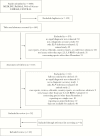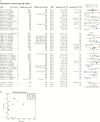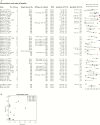A Systematic Review: Performance of Rapid Diagnostic Tests for the Detection of Plasmodium knowlesi, Plasmodium malariae, and Plasmodium ovale Monoinfections in Human Blood
- PMID: 29554284
- PMCID: PMC6009649
- DOI: 10.1093/infdis/jiy150
A Systematic Review: Performance of Rapid Diagnostic Tests for the Detection of Plasmodium knowlesi, Plasmodium malariae, and Plasmodium ovale Monoinfections in Human Blood
Abstract
Background: Despite the increased use and worldwide distribution of malaria rapid diagnostic tests (RDTs) that distinguish between Plasmodium falciparum and non-falciparum species, little is known about their performance detecting Plasmodium knowlesi (Pk), Plasmodium malariae (Pm), and Plasmodium ovale (Po). This review seeks to analyze the results of published studies evaluating the diagnostic accuracy of malaria RDTs in detecting Pk, Pm, and Po monoinfections.
Methods: MEDLINE, EMBASE, Web of Science, and CENTRAL databases were systematically searched to identify studies that reported the performance of RDTs in detecting Pk, Pm, and Po monoinfections.
Results: Among 40 studies included in the review, 3 reported on Pk, 8 on Pm, 5 on Po, 1 on Pk and Pm, and 23 on Pm and Po infections. In the meta-analysis, estimates of sensitivities of RDTs in detecting Pk infections ranged 2%-48%. Test performances for Pm and Po infections were less accurate and highly heterogeneous, mainly because of the small number of samples tested.
Conclusions: Limited data available suggest that malaria RDTs show suboptimal performance for detecting Pk, Pm, and Po infections. New improved RDTs and appropriately designed cross-sectional studies to demonstrate the usefulness of RDTs in the detection of neglected Plasmodium species are urgently needed.
Figures






References
-
- World Health Organization. World malaria report 2017 http://apps.who.int/iris/bitstream/10665/259492/1/9789241565523-eng.pdf. Accessed 19 February 2018.
-
- Sutherland CJ, Tanomsing N, Nolder D, et al. . Two nonrecombining sympatric forms of the human malaria parasite Plasmodium ovale occur globally. J Infect Dis 2010; 201:1544–50. - PubMed
Publication types
MeSH terms
LinkOut - more resources
Full Text Sources
Other Literature Sources
Medical

